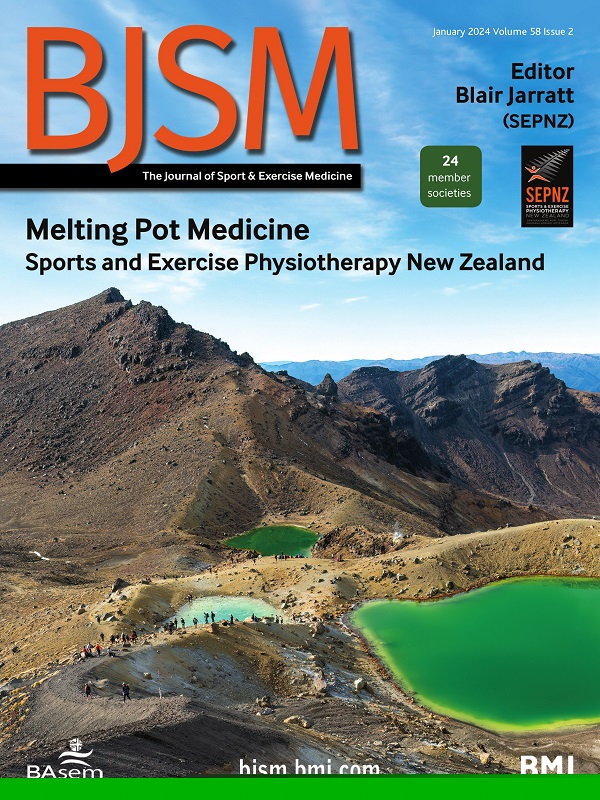Effectiveness of reducing tendon compression in the rehabilitation of insertional Achilles tendinopathy: a randomised clinical trial
IF 11.6
1区 医学
Q1 SPORT SCIENCES
引用次数: 0
Abstract
Objective To assess the effectiveness of low tendon compression rehabilitation (LTCR) versus high tendon compression rehabilitation (HTCR) for treating patients with insertional Achilles tendinopathy. Methods In an investigator-blinded, stratified randomised trial, 42 sport-active patients (30 males and 12 females; age 45.8±8.2 years) with chronic (> 3 months) insertional Achilles tendinopathy were allocated in a 1:1 ratio to receive LTCR or HTCR. Both rehabilitation protocols consisted of a progressive 4-stage tendon-loading programme, including isometric, isotonic, energy-storage and release and sport-specific exercises. The LTCR programme was designed to control Achilles tendon compression by limiting ankle dorsiflexion during exercise, eliminating calf stretching and incorporating heel lifts. The primary outcome was the Victorian Institute of Sports Assessment-Achilles (VISA-A) score at 12 and 24 weeks, which measures tendon pain and function and was analysed on an intention-to-treat basis using a linear mixed model. Significance was accepted when p<0.05. Results 20 patients were randomised to the LTCR group and 22 to the HTCR group. Improvement in VISA-A score was significantly greater for LTCR compared with HTCR after 12 weeks (LTCR=24.4; HTCR=12.2; mean between-group difference=12.9 (95% CI: 6.2 to 19.6); p<0.001) and after 24 weeks (LTCR=29.0; HTCR=19.3; mean between-group difference=10.4 (95% CI: 3.7 to 17.1); p<0.001). These differences exceeded the minimal clinically important difference of 10. Conclusions In sport-active patients with insertional Achilles tendinopathy, LTCR was more effective than HTCR in improving tendon pain and function at 12 and 24 weeks. Consequently, LTCR should be considered in the treatment of insertional Achilles tendinopathy. Trial registration number ClinicalTrials.gov (ID: [NCT05456620][1]). Data are available upon reasonable request. Data are available on reasonable request. The data sets generated during and/or analysed during the current study are available from the corresponding author on reasonable request. [1]: /lookup/external-ref?link_type=CLINTRIALGOV&access_num=NCT05456620&atom=%2Fbjsports%2Fearly%2F2025%2F02%2F26%2Fbjsports-2024-109138.atom减少跟腱压迫在插入性跟腱病康复中的有效性:一项随机临床试验
目的评价低肌腱压迫康复(LTCR)与高肌腱压迫康复(HTCR)治疗插入性跟腱病的疗效。方法采用研究者盲法分层随机试验,纳入42例运动患者(男性30例,女性12例;年龄45.8±8.2岁,慢性(bb0 - 3个月)跟腱插入性病变患者按1:1比例接受LTCR或HTCR。两种康复方案都包括一个渐进的4阶段肌腱负荷方案,包括等长、等张力、能量储存和释放以及运动特定练习。LTCR方案旨在通过限制运动期间的踝关节背屈,消除小腿拉伸和脚跟提升来控制跟腱压迫。主要结果是12周和24周时维多利亚运动评估学院跟腱(VISA-A)评分,该评分测量肌腱疼痛和功能,并使用线性混合模型在意向治疗基础上进行分析。p<0.05为有意义。结果20例患者随机分为LTCR组,22例患者随机分为HTCR组。12周后,LTCR与HTCR相比,VISA-A评分的改善明显更大(LTCR=24.4;HTCR = 12.2;平均组间差异=12.9 (95% CI: 6.2 ~ 19.6);p<0.001)和24周后(LTCR=29.0;HTCR = 19.3;平均组间差异=10.4 (95% CI: 3.7 ~ 17.1);p < 0.001)。这些差异超过了最小的临床重要差异10。结论在运动活跃的跟腱插入性病变患者中,在12周和24周时,LTCR比HTCR更有效地改善肌腱疼痛和功能。因此,在治疗插入性跟腱病时应考虑LTCR。试验注册号ClinicalTrials.gov (ID: [NCT05456620][1])。如有合理要求,可提供资料。如有合理要求,可提供资料。本研究期间产生和/或分析的数据集可根据通讯作者的合理要求提供。[1]: /查找/ external-ref ? link_type = CLINTRIALGOV&access_num = NCT05456620&atom = % 2 fbjsports % 2恐惧% 2 f2025 % 2 f02 % 2 f26 % 2 fbjsports - 2024 - 109138. -原子
本文章由计算机程序翻译,如有差异,请以英文原文为准。
求助全文
约1分钟内获得全文
求助全文
来源期刊
CiteScore
27.10
自引率
4.90%
发文量
217
审稿时长
3-8 weeks
期刊介绍:
The British Journal of Sports Medicine (BJSM) is a dynamic platform that presents groundbreaking research, thought-provoking reviews, and meaningful discussions on sport and exercise medicine. Our focus encompasses various clinically-relevant aspects such as physiotherapy, physical therapy, and rehabilitation. With an aim to foster innovation, education, and knowledge translation, we strive to bridge the gap between research and practical implementation in the field. Our multi-media approach, including web, print, video, and audio resources, along with our active presence on social media, connects a global community of healthcare professionals dedicated to treating active individuals.

 求助内容:
求助内容: 应助结果提醒方式:
应助结果提醒方式:


